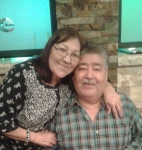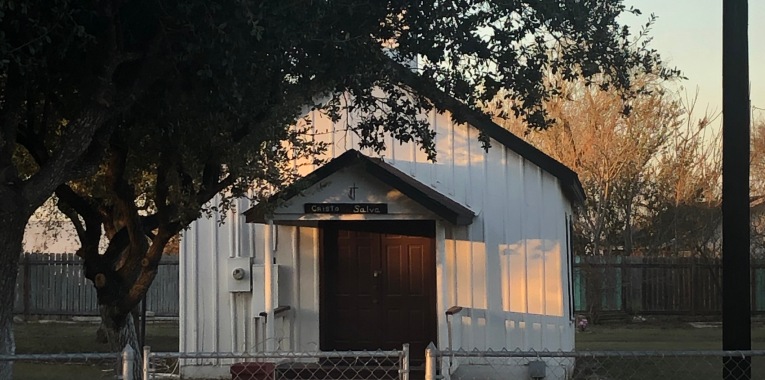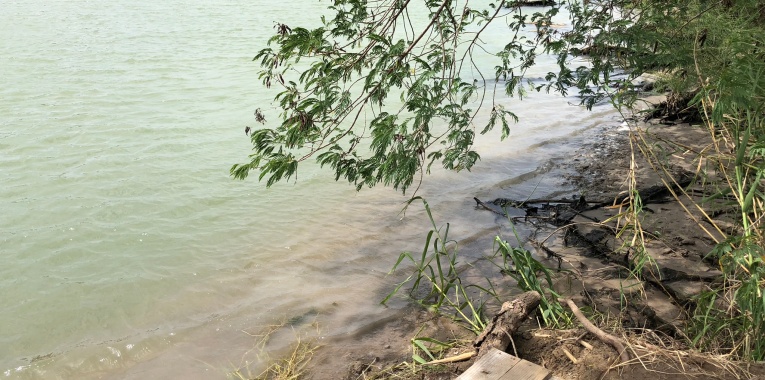I would like to give abrazos and a heartfelt thank you to everyone who has offered their prayers, thoughts, condolences, love, and support to our family these past few weeks. Seeing my mother going through pain devastated us, and then accepting it was time to let go was so very difficult; but your friendship and companionship has truly, truly been a blessing. I wouldn’t be surprised to have gained twenty pounds after all the pan dulce and hot meals brought over to my parents’ home lately. The tears you have shed for my mother, and for us, have made it clear we are not alone.
Our mother was a passionate woman, always amazing us with how many people she knew and her friendships from all moments of her existence. She never forgot the name that went with the face, nor the stories that went with the friendship. She loved, anyone and everyone.
The past year had been difficult for her, depending on others to drive her when she was used to her independence….always de pata larga, as my father would say. O de jacalera. Our memories with mom consist of dropping by to visit an old family friend, or a relative, and remembering to pick up a box of pan dulce or donas to take with us. And if a visit wasn’t possible, there she was with her hours long phone calls to catch up on chisme.
I can’t recall having ‘peaceful’ weekends at home either. Our house was always a jumble of visita, primos and friends staying over, and overrun by the many pets that came in and out of our home. From all of us, it was mami who would be tumbling outside in the backyard and playing with the pets…como si fuera niña. Our neighborhood puppies escaping their yards and coming over for a visit with her. At one point we even had a rooster as a pet and every morning, there was mami acariciandolo.
A few days before mami had been admitted into the hospital for the last time, she posted a video on Tío Robe’s Facebook page that made her reminisce about their childhood in the 50’s and 60’s. Sometimes, they would be here at home en el valle. At others, it was up en el norte doing migrant farmwork. The song was “He ain’t heavy, he’s my brother” by The Hollies. (Listen to song here: https://youtu.be/EYzfTdIZoP0)
It’s easy for me to picture the De La Garza siblings growing up near Bell Street in Pharr, TX, experiencing moments such as Uncle Ram being drafted and heading off to Vietnam War, the tumultuous Pharr Riots and the chaos that affected them and other neighborhood families, going to sock hops and dancing to the latest records in their school gyms, and heading out to Montemorelos for visits with their abuelo Tomas and Toñita.
Mami’s childhood always came up in her stories, usually making us giggle, confessing things such as how she would pin the blame on whoever was nearest when she’d hurt herself out of clumsiness. Everyone running in all directions as soon as they heard her cry, out of fear they’d be blamed.
Or how Uncle Ramiro would stash candy in his sock drawer and would blame Robe when he’d discover it missing…until the day he caught his cute baby sister red-handed. Not that I’m making a case for Robe. I mean, if he was the first one they pointed the finger at, it was for a reason.
The lyrics to this song by The Hollies say:
“The road is long / with many a winding turn
that leads us to who knows where / who knows where
but I’m strong / strong enough to carry him
he ain’t heavy, he’s my brother.”
These past few weeks, this song was a testament to what I’ve seen from many who loved her, but particularly her brothers (Robe and Ramiro) and sisters (Ninfa and Juani).
 And then I think of my father, the love of her life. She was so grateful for all he had done for her, spoiling her, taking her to the casinitos – legal or not – when he was exhausted, going on road trips to Oklahoma, or flying out to Vegas for a few days. Being her best friend and understanding her like no one else.
And then I think of my father, the love of her life. She was so grateful for all he had done for her, spoiling her, taking her to the casinitos – legal or not – when he was exhausted, going on road trips to Oklahoma, or flying out to Vegas for a few days. Being her best friend and understanding her like no one else.
According to my dad, and I know this isn’t true, the first time he saw her he thought she was my Tío Robe wearing a wig. La guera, his honey, as he called her. Ama and apa were so different, yet so alike. I can picture them at a baile, dancing to her favorite music, as mami let apa lead her with vuelta tras vuelta. A veces, her dress slip would fall after all those vueltas during a Tejano baile.
One of her favorite musicians was Jay Perez. Any time his music came out on the radio, a grito escaped her lungs. There is a song of his that goes (Listen to song here: https://youtu.be/syl4nP4ab88):
“Amor / Yo te e dado lo mejor de mi
Amor / como quiero estar cerca de ti
jamas / olvidarme de tu corazón
y volver amarte asi”.
To me, these are the lyrics in my father’s heart. As we go on, it’ll be most difficult for us to see him growing old without his güera by his side. I ask for you to help us remind him how much he is loved and needed as he heals from this heartbreak.
My first memories are of being about four years old and living out in a ranchito in Las Milpas. Back then, it was all monte and labores for miles. We had stray dogs that would end up in our ranchito, and on one particular day, I was outside being a diva and singing a Daniela Romo song to a crowd of about twelve dogs. Before you ask, no, they weren’t barking at me!
When I was done singing, I turned and saw mami smiling at me from the entrance to the house.
She called me in for a nap and as she sang me a lullaby, I looked out the window and wondered if my mami had a mami of her own. When I asked her, she explained her own mami lived too far away and that we’d have to climb a thousand steps into heaven to visit her. At some point while sleeping, I peeked my eyes open and saw mami silently sobbing as she looked out the window.
There have been many moments like this throughout my life and though I didn’t understand them then, I do understand now that I’m an adult.
I think about how fortunate we are to have had our mother into our adulthood, thinking how she was a kid when she lost hers. We will always miss her, but she left us with enough love for a lifetime. There has not been one single day in our lives when we have not known we are loved.
One of the things we’ve learned from our parents is that love is not something that expires, and the heart has no limit. Loving someone else doesn’t take away the love you already have for another. It helped my brothers and sisters bond and learn not to live with jealousy for one another. And I really thought I understood our mother’s love. That is, until grandchildren came into her life. Her Pingüinos Marinela and Chicharrones, as she called them.
 I can hear her singing a melody of Sonny and Cher to Tori Bambori, “Tori don’t go / pretty baby please don’t go”; putting a Tejano song on full blast and getting all her babies to make a riot dancing, carrying Navia on one arm and turning Luisito with the other; putting Diego and Fabian to sleep with one of her silly, made up stories; letting Julian get away with anything, scolding us to “Dejenlo!” when he broke yet another thing; asking to carry her baby Sophia when she had no strength left in her arms.
I can hear her singing a melody of Sonny and Cher to Tori Bambori, “Tori don’t go / pretty baby please don’t go”; putting a Tejano song on full blast and getting all her babies to make a riot dancing, carrying Navia on one arm and turning Luisito with the other; putting Diego and Fabian to sleep with one of her silly, made up stories; letting Julian get away with anything, scolding us to “Dejenlo!” when he broke yet another thing; asking to carry her baby Sophia when she had no strength left in her arms.
 Mom’s last days were filled with memories and love. And we’d like to thank all of you for sharing your stories of mom’s sense of humor and friendships. These past few days were filled with stories about running into las tías Suarez at bailes at Bocaccios 2000 and Starship, drinking zombies…whatever that is; empapachando her nephews and nieces; stories about abuelita Carmen and Toñita; and her being an accomplice with her grandchildren in so many ways.
Mom’s last days were filled with memories and love. And we’d like to thank all of you for sharing your stories of mom’s sense of humor and friendships. These past few days were filled with stories about running into las tías Suarez at bailes at Bocaccios 2000 and Starship, drinking zombies…whatever that is; empapachando her nephews and nieces; stories about abuelita Carmen and Toñita; and her being an accomplice with her grandchildren in so many ways.
Mom would often remind us after our visits, “Recuerden que tienen una mala madre y un buen padre…al revés!” Always joking but reminding us my parents would be there for us, regardless of the circumstances.
And that’s what I’d like to leave you with. A reminder. Her reminder.
Don’t forget to remember those who’ve loved you. Visit them, call them, let them know they are thought of. Particularly our viejitos.





































 And then I think of my father, the love of her life. She was so grateful for all he had done for her, spoiling her, taking her to the casinitos – legal or not – when he was exhausted, going on road trips to Oklahoma, or flying out to Vegas for a few days. Being her best friend and understanding her like no one else.
And then I think of my father, the love of her life. She was so grateful for all he had done for her, spoiling her, taking her to the casinitos – legal or not – when he was exhausted, going on road trips to Oklahoma, or flying out to Vegas for a few days. Being her best friend and understanding her like no one else. I can hear her singing a melody of Sonny and Cher to Tori Bambori, “Tori don’t go / pretty baby please don’t go”; putting a Tejano song on full blast and getting all her babies to make a riot dancing, carrying Navia on one arm and turning Luisito with the other; putting Diego and Fabian to sleep with one of her silly, made up stories; letting Julian get away with anything, scolding us to “Dejenlo!” when he broke yet another thing; asking to carry her baby Sophia when she had no strength left in her arms.
I can hear her singing a melody of Sonny and Cher to Tori Bambori, “Tori don’t go / pretty baby please don’t go”; putting a Tejano song on full blast and getting all her babies to make a riot dancing, carrying Navia on one arm and turning Luisito with the other; putting Diego and Fabian to sleep with one of her silly, made up stories; letting Julian get away with anything, scolding us to “Dejenlo!” when he broke yet another thing; asking to carry her baby Sophia when she had no strength left in her arms. Mom’s last days were filled with memories and love. And we’d like to thank all of you for sharing your stories of mom’s sense of humor and friendships. These past few days were filled with stories about running into las tías Suarez at bailes at Bocaccios 2000 and Starship, drinking zombies…whatever that is; empapachando her nephews and nieces; stories about abuelita Carmen and Toñita; and her being an accomplice with her grandchildren in so many ways.
Mom’s last days were filled with memories and love. And we’d like to thank all of you for sharing your stories of mom’s sense of humor and friendships. These past few days were filled with stories about running into las tías Suarez at bailes at Bocaccios 2000 and Starship, drinking zombies…whatever that is; empapachando her nephews and nieces; stories about abuelita Carmen and Toñita; and her being an accomplice with her grandchildren in so many ways.
 Edward Vidaurre is the author of four books. I Took My Barrio On A Road Trip (Slough Press 2013), Insomnia (El Zarape Press 2014), Beautiful Scars: Elegiac Beat Poems (El Zarape Press 2015), and his latest collection Chicano Blood Transfusion (FlowerSong Books) was published this year. Vidaurre is the founder of Pasta, Poetry, and Vino–a monthly open mic gathering of artists, poets, and musicians. He resides in McAllen, TX with his wife and daughter.
Edward Vidaurre is the author of four books. I Took My Barrio On A Road Trip (Slough Press 2013), Insomnia (El Zarape Press 2014), Beautiful Scars: Elegiac Beat Poems (El Zarape Press 2015), and his latest collection Chicano Blood Transfusion (FlowerSong Books) was published this year. Vidaurre is the founder of Pasta, Poetry, and Vino–a monthly open mic gathering of artists, poets, and musicians. He resides in McAllen, TX with his wife and daughter. Rodney Gomez is the author of Citizens of the Mausoleum (2018), Baedeker from the Persistent Refuge (2019), and the chapbooks Mouth Filled with Night (winner of the Drinking Gourd Chapbook Prize from Northwestern University), Spine (selected by Ada Limón as winner of the Gloria Anzaldúa Poetry Prize), and A Short Tablature of Loss (selected by Eduardo Corral as winner of the Rane Arroyo Prize). His work has appeared in Poetry, The Gettysburg Review, Blackbird, Pleiades, Denver Quarterly, Puerto del Sol, and other journals. He is the son of migrant farm workers and the first in his family to attend college. A proud member of the Macondo Writers’ Workshop and the Chocholichex writing collective, he was educated at Yale, Arizona State, Berkeley, Cornell, and the University of Texas-Pan American. He reviews poetry and nonfiction for Latino Book Review and works at the University of Texas Rio Grande Valley. He lives with the love of his life, Sara, in McAllen.
Rodney Gomez is the author of Citizens of the Mausoleum (2018), Baedeker from the Persistent Refuge (2019), and the chapbooks Mouth Filled with Night (winner of the Drinking Gourd Chapbook Prize from Northwestern University), Spine (selected by Ada Limón as winner of the Gloria Anzaldúa Poetry Prize), and A Short Tablature of Loss (selected by Eduardo Corral as winner of the Rane Arroyo Prize). His work has appeared in Poetry, The Gettysburg Review, Blackbird, Pleiades, Denver Quarterly, Puerto del Sol, and other journals. He is the son of migrant farm workers and the first in his family to attend college. A proud member of the Macondo Writers’ Workshop and the Chocholichex writing collective, he was educated at Yale, Arizona State, Berkeley, Cornell, and the University of Texas-Pan American. He reviews poetry and nonfiction for Latino Book Review and works at the University of Texas Rio Grande Valley. He lives with the love of his life, Sara, in McAllen.